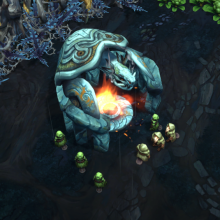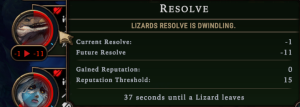Villagers
Overview
Villagers are the inhabitants of Viceroy settlements. The number and species of villagers you are going to have at the start of your settlement are determined by the Caravan you pick on the World Map. Newcomers come to your settlement at regular intervals (every 10 minutes by default). Additional villagers can also be obtained by completing Orders or Glade Events. There are also Cornerstones like Surprise Child that reward villagers every time their conditions are fulfilled.
Resolve
- Main article: Resolve
Each villager has a Resolve stat. Resolve is the main indicator of the villagers’ well-being. It’s represented by a number between -50 and 50, and is calculated for each species based on its Base Resolve and all positive and negative effects influencing it. Current and Future Resolve are shown below the Species icon. Current Resolve reflects the Resolve a given species currently has, and Future Resolve is the sum of all effects – in other words, the value that the Current Resolve will eventually reach over time. While Future Resolve may exceed 50, Current Resolve can never rise above that mark.
To increase Resolve, you have to satisfy your villagers’ needs by giving them Housing, Complex Food (like ![]() Jerky,
Jerky, ![]() Pie, etc.), Clothing, or access to Services (like a Tavern serving
Pie, etc.), Clothing, or access to Services (like a Tavern serving ![]() Ale). When Resolve goes above the High Resolve threshold, villagers will start generating Reputation and will generate Reputation as long as they stay above the High Resolve mark. The speed at which Reputation is generated scales with the number of villagers and how high above the High Resolve threshold they are. However, villagers get used to their standard of living, so their High Resolve threshold goes up after each point of Reputation acquired, up to the maximum of 50. If Resolve falls to 0 or lower, villagers will start leaving. The rate at which villagers leave depends on how low Resolve falls.
Ale). When Resolve goes above the High Resolve threshold, villagers will start generating Reputation and will generate Reputation as long as they stay above the High Resolve mark. The speed at which Reputation is generated scales with the number of villagers and how high above the High Resolve threshold they are. However, villagers get used to their standard of living, so their High Resolve threshold goes up after each point of Reputation acquired, up to the maximum of 50. If Resolve falls to 0 or lower, villagers will start leaving. The rate at which villagers leave depends on how low Resolve falls.
To see the Resolve and Reputation breakdown of a species, hover over their Resolve Bar. There, you will find the Current Resolve and Future Resolve, as well as information about gained Reputation and the current Reputation Threshold.
Species
Each villager is a member of one of 5 species. In any given settlement you are going to have only 3 species, and they are determined when you embark (not when the villager joins your settlement).
| Species | Description |
|---|---|
 Humans Humans
|
"An adaptable species, but very susceptible to the rain." |
 Beavers Beavers
|
"Beavers are hardworking and honest, but also quite demanding." |
 Lizards Lizards
|
"Lizards are a very resilient and distrustful species." |
 Harpies Harpies
|
"Harpies are a noble and fragile species, yet with a primal, aggressive side." |
 Foxes Foxes
|
"Foxes are majestic and mysterious creatures deeply bonded with the forest. " |
Resolve stats
Each species has the following stats describing their Resolve:
- Base Resolve
- The species's Resolve without any positive or negative effects.
- Resilience
- How fast the species reacts to change. A species with a higher resilience reacts very slowly to Resolve effects.
- Demand
- Also called Resolve Threshold, how much Resolve a species needs before they start generating Reputation for their viceroy.
- Decadence
- How much their Demand raises after they earn their viceroy a Reputation Point through their own high Resolve.
- Hunger Tolerance
- The maximum amount of Hunger a villager can withstand before dying.
- Break Interval
- The minimum amount of time before a villager will take a break at a Hearth.
| Species | Base Resolve | Resilience | Demand (Resolve Threshold) | Decadence | Hunger threshold | Break interval |
|---|---|---|---|---|---|---|
 Humans Humans
|
15 | low | 30 | 4 | 6 | 2:00 |
 Beavers Beavers
|
10 | low | 30 | 2 | 6 | 2:00 |
 Lizards Lizards
|
5 | high | 15 | 7 | 12 | 1:40 |
 Harpies Harpies
|
5 | low | 15 | 3 | 4 | 1:40 |
 Foxes Foxes
|
5 | low | 15 | 5 | 3 | 2:00 |
Specializations
Each species has the following two types of specializations:
- Proficiency Specialization
- Grants most villagers a 10% chance to produce twice the amount of resources when working in that specialization. For
 Foxes, their
Foxes, their  Forest Proficiency Specialization grants them +5% working speed on Glade Events.
Forest Proficiency Specialization grants them +5% working speed on Glade Events. - Comfort Specialization
- Grants villagers +5 to their individual Resolve when working in that specialization.
| Species | Comfort | Proficiency |
|---|---|---|
 Humans Humans |
||
 Beavers Beavers |
Lua error in Module:SpecializationLink at line 56: No specialization found with that name: Wood. | |
 Lizards Lizards |
||
 Harpies Harpies |
Lua error in Module:SpecializationLink at line 56: No specialization found with that name: Cloth. | |
 Foxes Foxes |
Needs
- Main articles: Housing Need, Complex Food Need, Clothing Need, Services Needs
Each species has the following needs:
- Shelter Need
- Every villager needs to have a roof of some kind over their head. Every species has a
 Shelter Need. This is omitted from the following table.
Shelter Need. This is omitted from the following table. - Housing Need
- Also called Species-specific Housing, their need for the comforts of home unique to their species.
- Complex Food Need
- Their need for tasty food that isn't raw, but cooked or made up of several ingredients to their liking.
- Service Need
- Their need for consumption of fine goods related to comforts, relaxation, and self-improvement.
| Species | Housing Need | Complex Food Needs | Clothing Needs | Services Needs | ||||||
|---|---|---|---|---|---|---|---|---|---|---|
 Humans Humans
|
||||||||||
 Beavers Beavers
|
||||||||||
 Lizards Lizards
|
none | |||||||||
 Harpies Harpies
|
||||||||||
 Foxes Foxes
|
none |
Workers
Villagers can be assigned to Hearths, Camps, Farms, Mines, Production Buildings, Service Buildings, Geyser Pumps, Warehouses, Blight Posts, and Glade Events. Once assigned, villagers will immediately begin performing their work, unless they were on a break or travelling to the nearest Hearth to take a break, in which case they finish their break first before starting with their job. All unassigned villagers count as Builders.
When villagers die, an alert appears telling you what job the villager had. You can click on the alert to show their workplace.
| Name of Job | Building |
|---|---|
| "Blight fighter" | Blight Post |
| "Craftsman" | Makeshift Post |
| "Druid" | Druid's Hut |
| "Farmer" | Farms |
| "Firekeeper" | Hearths |
| "Gatherer" | Gathering Camps |
| "Hauler" | Warehouses |
| "Scout" | Glade Events |
| "Woodcutter" | Woodcutters' Camp |
| "Miner" | Mine |
| "Worker" | Either generically, or the alert may specify "Greenhouse Worker" identifying that the worker was in the Greenhouse. |
Caravans
The caravan you pick before Embarking, along with the Embarkation Points you spend, are going to determine the species and number of your starting villagers, as well as your starting resources. You only have 2 caravans available in the caravan menu when starting out. In order to unlock the third one, you have to acquire Level 12 Obsidian Archives Upgrade. Only 1 or 2 of the starting species can be known before you start a settlement, never all 3.
Every caravan has Base Goods and a few bonus resources:
| No upgrades | Fully upgraded citadel |
|---|---|
| 30 |
42 |
| 20 |
28 |
| 4 |
6 |
| 10 |
14 |
| 20 |
28 |
| — | 7 |
| — | 7 |
| — | 7 |
| — | 14 |
 Hooded Horse Wikis
Hooded Horse Wikis



